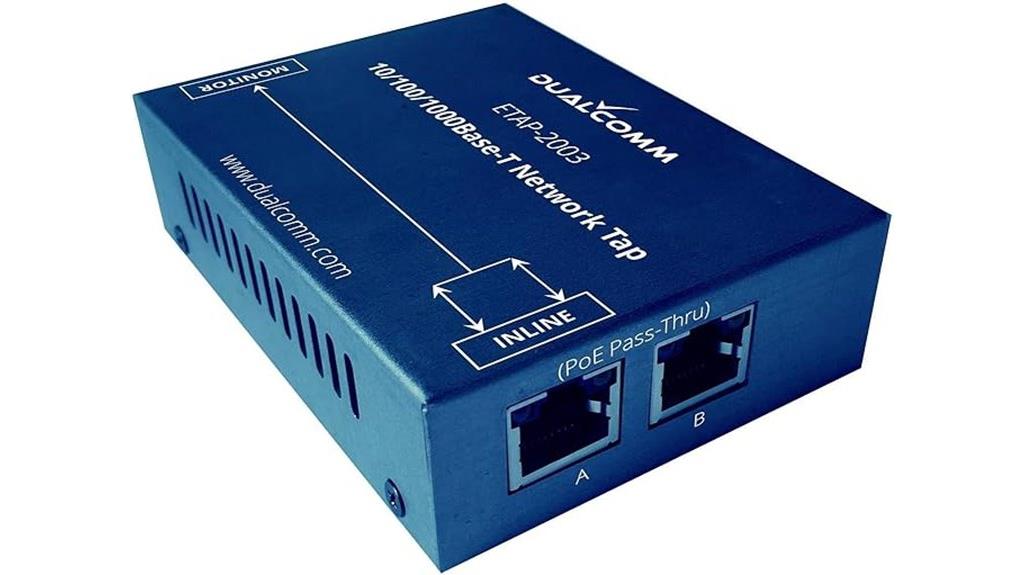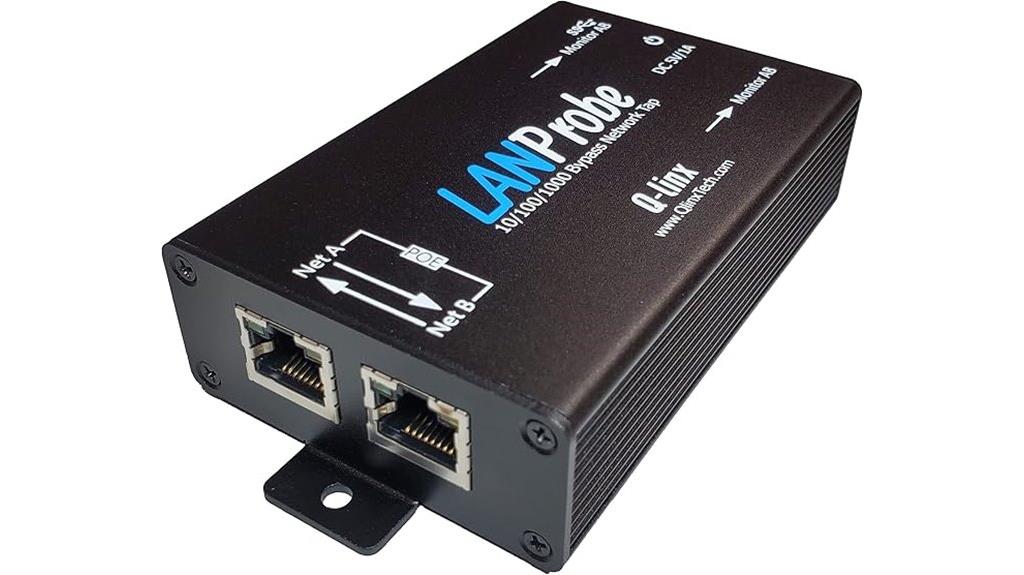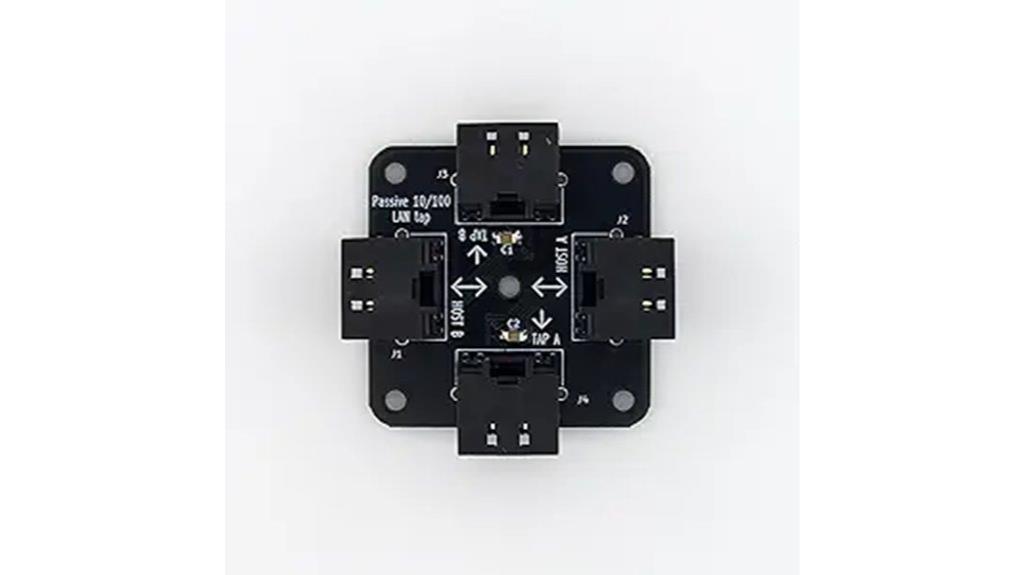If you’re looking for the best gigabit network taps for seamless data monitoring in 2025, I suggest focusing on reliable, high-performance options like the ETAP-2003, SharkTap, and Upgraded Passive LAN Tap. These products support full gigabit speeds, minimal packet loss, and easy plug-and-play setup, perfect for security and troubleshooting. They’re durable and discreet, suitable for various environments. Keep going to discover the top models and what makes them stand out.
Key Takeaways
- Select gigabit network taps supporting full 1 Gbps throughput with minimal packet loss for accurate data monitoring.
- Prioritize passive, plug-and-play designs that are durable, portable, and easy to deploy in various environments.
- Consider models offering high compatibility with analysis tools like Wireshark and tcpdump for seamless traffic capture.
- Opt for taps with flexible power options, including passive, USB, or PoE support, based on deployment needs.
- Review devices with robust construction, shielding, and fail-safe features to ensure reliable performance in demanding settings.
ETAP-2003 10/100/1000Base-T Gigabit Ethernet Network TAP

If you’re looking for a reliable, portable Gigabit Ethernet tap that’s perfect for network troubleshooting and security monitoring, the ETAP-2003 stands out. This compact device captures data traffic without packet loss over full 1 Gbps throughput, even at 200 meters of cable. Made with a durable metal case, it’s easy to transport and deploy in the field. It supports Power-over-Ethernet (PoE) and can be powered via USB, with built-in inrush current limiting for safety. Mirroring port 1 to port 5, it preserves MAC addresses and leaves other ports functional, making it ideal for detailed traffic analysis and security tasks.
Best For: network security professionals, IT troubleshooters, and small to medium-sized businesses seeking reliable, portable Gigabit Ethernet monitoring tools.
Pros:
- Captures full 1 Gbps traffic without packet loss over 200 meters of cable.
- Compact, durable metal case for easy transport and field deployment.
- Supports Power-over-Ethernet (PoE) and USB power with inrush current limiting for safety.
Cons:
- Minimal manual; may require prior network hardware knowledge for setup.
- Limited to mirroring port 1 to port 5; other ports function as regular switches.
- Slightly higher price compared to basic non-monitoring network switches, though still affordable.
10/100/1000 Gigabit Ethernet/USB Bypass Network Tap

The 100/1000 Gigabit Ethernet/USB Bypass Network Tap is ideal for network professionals who need reliable, non-intrusive monitoring of high-speed networks. It captures traffic via switch port mirroring, supporting gigabit speeds and full duplex packet capture through USB3 or Ethernet ports. With automatic power-fail bypass, it ensures continuous network flow during outages. The device supports CRC error and jumbo frame capture, making it versatile for diagnosing network issues, IoT, or industrial systems. Its durable aluminum housing adds portability, while compatibility with tools like Wireshark simplifies analysis. Although some packet drops occur at high loads, overall, it offers a cost-effective, dependable solution for seamless data monitoring.
Best For: network professionals seeking a reliable, portable, and cost-effective solution for high-speed network monitoring and troubleshooting.
Pros:
- Supports gigabit speeds with full duplex packet capture via USB3 and Ethernet ports.
- Equipped with automatic power-fail bypass ensuring continuous network operation during outages.
- Compatible with popular analysis tools like Wireshark and tcpdump for easy traffic analysis.
Cons:
- May experience packet drops or filtering issues at high traffic loads or on saturated links.
- Requires external power cables (not included) for some configurations, which can affect portability.
- Configuration can be complex on Mac OS or with certain drivers, possibly requiring troubleshooting.
SharkTap Gigabit Network Sniffer

Designed for network professionals who need reliable, real-time traffic analysis, SharkTap Gigabit Network Sniffer offers zero-delay packet duplication across 10/100/1000Base-T Ethernet links. It’s purpose-built for thorough traffic capture without impacting network performance, supporting high-speed Ethernet, PoE pass-through, and auto-MDIX. Its protocol-agnostic, byte-accurate copper repeater technology ensures precise monitoring. Compact and portable, it’s ideal for lab and field use, compatible with Wireshark and similar analyzers. While it lacks pass-through during power loss and deep buffering, its dependability and ease of deployment make it a popular choice for network troubleshooting in demanding environments.
Best For: network professionals needing reliable, real-time gigabit Ethernet traffic analysis in lab or field environments.
Pros:
- Zero-delay packet duplication ensures accurate traffic capture without impacting network performance
- Compact, portable design ideal for field kits and lab setups
- Protocol-agnostic, byte-accurate technology supports comprehensive analysis at gigabit speeds
Cons:
- Does not support pass-through during power loss, stopping through-communication if power fails
- Lacks deep buffering capabilities, limiting performance during high-throughput conditions
- No PoE power options, requiring external power supply via micro-USB
Upgraded Passive LAN Tap

For professionals seeking reliable passive monitoring solutions, the Upgraded Passive LAN Tap offers a streamlined, modern design without sacrificing performance. It features Throwing Star LAN tap functionality, enabling efficient Ethernet traffic monitoring. The device’s sleek, intuitive silkscreen enhances usability and aesthetics. Hand-assembled in the USA, each tap undergoes rigorous inspection and testing to guarantee top quality. All components are sourced from reputable suppliers, assuring durability and reliability. Maintaining the core LAN tap capabilities of previous models, this upgrade simplifies installation and operation while delivering robust passive monitoring. It’s an ideal choice for seamless data capture in demanding network environments.
Best For: network professionals and engineers seeking reliable, passive Ethernet monitoring in demanding environments.
Pros:
- Streamlined, modern design with intuitive silkscreen for ease of use
- Hand-assembled in the USA with rigorous quality inspections
- Incorporates Throwing Star LAN tap functionality for efficient traffic monitoring
Cons:
- May require technical expertise for installation and integration
- Limited to passive monitoring; not suitable for active network management
- Potentially higher cost compared to basic passive taps due to quality assurance and sourcing
Throwing Star LAN Tap Network Packet Capture Mod

If you’re seeking a discreet and reliable way to monitor Ethernet traffic without disrupting your network, the Throwing Star LAN Tap Network Packet Capture Mod stands out. It’s a compact, passive device that appears as a standard cable, extending wires to monitoring ports without needing power. Simply connect the Ethernet cables from your network to the tap and link your monitoring stations to the output ports. This setup enables real-time data capture with software like Wireshark or tcpdump, all without interfering with network operations. Its passive design makes it portable and unobtrusive, perfect for troubleshooting, security, or traffic analysis in any gigabit network environment.
Best For: network administrators, security professionals, and IT technicians seeking discreet, power-free Ethernet traffic monitoring solutions.
Pros:
- Passive, no power required, making it highly portable and simple to deploy
- Provides real-time traffic capture without interfering with network performance
- Discreet and unobtrusive, ideal for secure or sensitive environments
Cons:
- Limited to Ethernet monitoring; cannot modify or actively analyze traffic
- Installation requires physical access to network cables, which may be invasive
- No active filtering or advanced analysis capabilities built into the device
TP-Link 5-Port Gigabit Ethernet Switch

The TP-Link TL-SG105E stands out as an ideal choice for small offices or home networks that need reliable, high-speed connectivity without complicated setup. Its sturdy metal design and shielded ports ensure durability and consistent performance. With five Gigabit Ethernet ports, expanding your network is simple and efficient. The smart management interface allows effortless configuration via web or free software, giving you control without hassle. Features like VLAN segmentation, port mirroring, and QoS help optimize traffic and enhance security. Plus, the lifetime warranty underscores its reliability. Overall, this switch provides a straightforward, robust solution for seamless data monitoring and network expansion.
Best For: small offices and home networks seeking reliable, high-speed Ethernet connectivity with easy management and security features.
Pros:
- Easy plug-and-play setup with no complex configuration needed
- Robust metal design with shielded ports for durability and performance
- Supports advanced features like VLAN, QoS, and port mirroring for traffic management
Cons:
- Limited to five ports, which may not suit larger network expansions
- Lacks advanced management features found in higher-end switches
- No Power over Ethernet (PoE) support for powering devices through Ethernet
EDIY Throwing Star LAN Tap Network Packet Capture Mod

The EDIY Throwing Star LAN Tap stands out as an ideal choice for network admins and security pros needing a discreet, passive device to monitor Ethernet traffic without disrupting the network. It looks like a standard cable segment, making it nearly invisible in the network setup. Simply connect it inline with your Ethernet cables, and use monitoring ports to capture traffic with tools like Wireshark or tcpdump. Its passive design requires no power and maintains network transparency. This compact, authentic-looking device provides reliable traffic analysis, troubleshooting, and security monitoring, all while seamlessly blending into your network infrastructure.
Best For: network administrators and security professionals seeking a passive, discreet solution for Ethernet traffic monitoring without network disruption.
Pros:
- Passive and requires no power, ensuring seamless operation without added complexity
- Discreet, cable-like design makes it nearly invisible within the network setup
- Compatible with popular analysis tools like Wireshark and tcpdump for effective traffic monitoring
Cons:
- Monitors traffic in only one direction per port, limiting comprehensive bidirectional analysis
- Requires physical connection inline with existing Ethernet cables, which may be challenging in tight spaces
- No active filtering or processing capabilities, relying solely on external analysis tools
NETGEAR 5-Port Gigabit Ethernet Switch (GS305)

For home offices and small setups that need reliable, high-speed wired connections, the NETGEAR GS305 offers a straightforward solution. This 5-port Gigabit Ethernet switch is unmanaged, plug-and-play, and requires no configuration. Its durable metal case guarantees longevity, while LED indicators help monitor each port’s activity. The device supports auto MDI/MDI, auto negotiation, and non-blocking switching, providing seamless gigabit speeds at 1,000 Mbps. It’s energy-efficient, silent, and easy to mount on a desk or wall. Many users praise its reliable performance, simple setup, and sturdy design, making it ideal for expanding wired networks without fuss.
Best For: small home offices and entertainment setups requiring reliable, high-speed wired connections with easy installation.
Pros:
- Plug-and-play setup with no configuration needed
- Durable metal case and silent operation for long-term use
- Supports full gigabit speeds at 1,000 Mbps per port
Cons:
- Limited to five ports, which may be insufficient for larger networks
- Designed for North American power standards, not universally compatible
- No advanced management features or VLAN support
Throwing Star LAN Tap Network Packet Capture Mod

If you’re seeking a reliable, passive solution for capturing network traffic without adding complexity or power requirements, the Throwing Star LAN Tap Network Packet Capture Mod stands out. It’s a compact, inline device that appears as a regular cable, enabling traffic monitoring without active components or power. Simply connect it between network devices, and it passively captures Ethernet communication. The tap supports software like Wireshark or tcpdump, making traffic analysis straightforward. Its passive design ensures minimal network impact, high portability, and reliable data capture. This makes it an excellent choice for secure, non-intrusive network monitoring in any environment.
Best For: security professionals and network administrators seeking a portable, non-intrusive method to monitor Ethernet traffic without active network components.
Pros:
- Passive design requires no power, simplifying deployment and maintenance
- Ensures minimal impact on network performance and security
- Compact and easy to install inline between network devices
Cons:
- Monitors traffic in only one direction per port, potentially limiting visibility
- Does not support active filtering or advanced analysis features
- Physical connection setup may be less flexible in complex network topologies
1-to-3 10/100/1000Base-T Ethernet Flow Switch Tap, Black

When monitoring network traffic across multiple devices, the to-3 10/100/1000Base-T Ethernet Flow Switch Tap in black stands out as an ideal choice for network professionals seeking reliable, multi-port traffic capture. This portable device supports three Ethernet ports, allowing simultaneous traffic monitoring on the same segment. It’s powered via a USB port and features PoE pass-through, making it versatile for various setups. Though it may cause minor packet fragmentation on mirrored ports, its performance is solid and cost-effective. I find it perfect for troubleshooting, traffic analysis, and performance monitoring across multiple devices, especially when portability and multi-port access are priorities.
Best For: network professionals needing reliable, multi-port traffic monitoring and analysis in portable, versatile setups.
Pros:
- Supports up to three Ethernet ports for simultaneous traffic capture
- Powered via USB with PoE pass-through for flexible deployment
- Compact and portable design ideal for various network environments
Cons:
- May cause minor packet fragmentation on mirrored ports
- Slight potential for traffic disturbances during high surge conditions
- Not suitable for environments requiring zero packet loss or advanced filtering
Throwing Star LAN Tap Network Packet Capture Mod

The Throwing Star LAN Tap Network Packet Capture Mod stands out as an ideal choice for security professionals and network troubleshooters who need a reliable, portably passive monitoring solution. Its compact design and passive operation mean it requires no power and integrates seamlessly into existing networks. By connecting inline with Ethernet cables, it captures traffic in one direction per port, providing real-time insights without disrupting network flow. Compatible with tools like Wireshark and tcpdump, it offers detailed traffic analysis while maintaining network integrity. This device’s simplicity and effectiveness make it perfect for security testing, troubleshooting, and network analysis on the go.
Best For: security professionals, network troubleshooters, and IT personnel seeking portable, passive Ethernet monitoring solutions for real-time traffic analysis without network disruption.
Pros:
- No power required due to passive design, increasing portability and ease of use
- Seamless integration into existing networks without causing downtime or disruptions
- Compatible with standard monitoring tools like Wireshark and tcpdump for detailed analysis
Cons:
- Monitors traffic in only one direction per port, limiting full bidirectional analysis on a single port
- May require additional hardware or multiple units for comprehensive two-way traffic monitoring
- Passive nature means it cannot actively influence or filter network traffic, limiting control features
TP-Link 8 Port Gigabit Ethernet Network Switch

The TP-Link TL-SG108 stands out as an ideal choice for small offices or home users seeking a reliable, easy-to-use solution. Its 8-port Gigabit Ethernet design offers fast, stable connections with plug-and-play setup, eliminating the need for complex configuration. The sturdy metal casing guarantees durability, heat dissipation, and EMI protection, while the fanless design keeps operation silent. Features like QoS and IGMP Snooping optimize traffic, prioritizing critical data like video and voice. Plus, energy-efficient technology reduces power consumption, and the loop prevention button enhances network stability. Overall, this switch combines simplicity, reliability, and performance—perfect for expanding networks and seamless data monitoring.
Best For: small offices and home users seeking a reliable, easy-to-install network switch with high-speed connectivity and energy efficiency.
Pros:
- Easy plug-and-play setup with no configuration needed
- Durable metal casing with heat dissipation and EMI protection
- Supports traffic prioritization with QoS and IGMP Snooping for smooth video and voice transmission
Cons:
- Limited to unmanaged switch features without advanced network management options
- No built-in fan, which may reduce cooling for high-traffic environments in extended use
- Lacks additional features like PoE or advanced security options
Factors to Consider When Choosing Gigabit Network Taps

When selecting a gigabit network tap, I focus on compatibility with my network speed to guarantee seamless data flow. I also consider power supply options and the number of ports needed for my setup. Additionally, ease of installation and monitoring capabilities play a key role in making the right choice.
Compatibility With Network Speed
Choosing a gigabit network tap requires careful attention to compatibility with your network’s speed capabilities. First, confirm the tap explicitly supports 10/100/1000 Mbps speeds to match your network’s maximum throughput. Verify that the ports are compatible with your cabling type, whether it’s CAT5e, CAT6, or fiber, to maintain exceptional gigabit performance. It’s also essential to check that the hardware and firmware support full duplex transmission at gigabit speeds, avoiding latency or packet loss. Additionally, confirm the tap’s backward compatibility with lower speeds, especially in mixed environments. Finally, review the manufacturer’s documentation to ensure the device can handle peak traffic loads without compromising data integrity. Proper compatibility guarantees reliable data monitoring without bottlenecks or interruptions.
Power Supply Options
Selecting the right power supply option is vital for guaranteeing your gigabit network tap operates reliably and fits seamlessly into your setup. Many models can be powered via USB, offering a portable, easy-to-use solution without external adapters. This is ideal for mobile setups or temporary monitoring. Others support Power-over-Ethernet (PoE), allowing the tap to draw power directly from the network switch or PoE injector, simplifying deployment and reducing clutter. Passive taps are another option—they don’t need external power and are perfect for environments with limited power sources or where minimal network interference is essential. Some models provide dual power options, giving you greater flexibility across different network environments. Ultimately, choosing a power supply that aligns with your deployment needs guarantees consistent performance and easy integration.
Port and Port Count
The number of ports on a gigabit network tap directly impacts how many network segments or devices you can monitor at once. More ports mean you can monitor multiple links or devices simultaneously, which is vital for thorough network analysis. Some taps support multiple traffic replication configurations, like 1-to-3 or 1-to-5, enabling broader visibility without extra hardware. However, higher port counts often increase the size and complexity of the tap, requiring more space and making setup more involved. Choosing the right port and port count depends on your network’s size, the number of links you need to monitor, and your overall scope. Balancing monitor capacity with physical and operational considerations ensures you select a tap that fits your specific monitoring needs.
Ease of Installation
When installing a gigabit network tap, simplicity matters because it can save you time and reduce errors. I look for plug-and-play options that require minimal setup, making deployment quick and straightforward. Clear wiring diagrams or minimal cabling are essential, so I can connect everything without fuss. Passive or non-powered taps are preferable for easy installation since they don’t need external power sources. I also check for connection ports that match my existing cables, like RJ45 or SFP slots, to avoid extra adapters. The fewer components a device has, the easier it is to install, especially with clear labels guiding the process. Ultimately, choosing a tap designed for quick, error-free setup helps me monitor my network efficiently without unnecessary hassle.
Monitoring Capabilities
Monitoring capabilities are a key factor when choosing a gigabit network tap, as they determine how effectively I can analyze my network traffic. I look for devices that can capture full-duplex traffic at speeds up to 1 Gbps with minimal packet loss, ensuring I don’t miss vital data. It’s important that the tap supports capturing CRC errors, jumbo frames, and other special Ethernet frames for thorough analysis. Some taps are passive, while others include features like pass-through or fail-safe bypass to keep the network running smoothly during failures. The quality of monitoring hinges on the tap’s ability to duplicate packets accurately without adding latency or causing drops. Compatibility with analysis tools like Wireshark or tcpdump is essential for extracting valuable insights from the captured data.
Device Durability
Choosing a gigabit network tap that can withstand harsh conditions is essential for reliable performance, especially in field deployments. I look for devices housed in sturdy metal enclosures, which offer better protection against physical damage and environmental factors compared to plastic cases. The construction quality matters too — high-quality soldering and reinforced connectors help guarantee longevity and resist wear and tear. Rugged, impact-resistant cases are fundamental when accidental drops or impacts are common. Proper shielding and grounding are indispensable for preventing electrical interference, which can damage the device and affect performance over time. Additionally, I check the rated operating temperature range to guarantee consistent performance in various climates. These durability features give me confidence that the tap will perform reliably, even in challenging environments.
Cost and Budget
Budget plays a significant role in selecting the right gigabit network tap, as prices can vary widely from around $200 for basic models to over $1,000 for high-end options. While affordable taps may seem attractive, they often lack advanced features like PoE support or fail-safe bypass, which are vital for long-term reliability. Your budget constraints will influence whether you choose passive, active, or hybrid solutions, each with different costs and benefits. Keep in mind that the total cost of ownership includes accessories, maintenance, and potential upgrades, not just the initial purchase. To make a smart choice, balance features, durability, and support against your budget—finding a solution that meets your monitoring needs without overspending is key.
Frequently Asked Questions
How Do Network Taps Differ From Traditional Network Monitoring Tools?
Network taps differ from traditional monitoring tools because they provide a dedicated, passive way to access data without interrupting network traffic. Unlike sniffers or probes that can affect performance, taps simply duplicate data streams, ensuring seamless monitoring. I find that taps are more reliable and transparent, making them ideal for high-speed networks where maintaining data integrity and minimizing latency are essential.
What Are the Key Security Considerations for Using Gigabit Network Taps?
You might worry about security risks when using gigabit network taps, but I can assure you that proper measures make them safe. Always encrypt sensitive data and restrict access to authorized personnel. Regularly update firmware and monitor for unauthorized activity. Using trusted vendors and secure installation practices minimizes vulnerabilities. With these precautions, gigabit taps provide powerful monitoring without compromising your network’s security.
Can Gigabit Network Taps Be Used in Wireless Network Environments?
Yes, gigabit network taps can be used in wireless network environments, but they require some setup. I connect them to the wired part of the wireless access points or switches to monitor the traffic effectively. This way, I can capture data without disrupting wireless connections. Just make certain the tap supports wireless integration and that you have proper placement for maximum monitoring and security.
How Does Latency Impact Data Accuracy With Gigabit Network Taps?
Latency can critically impact data accuracy—delays over 1 millisecond can cause data to become outdated or misaligned. I’ve seen how even slight latency increases distort real-time monitoring, leading to incorrect insights. When using gigabit network taps, minimizing latency is vital for precise data capture. If delays occur, it compromises the reliability of the data, especially in high-speed environments where accuracy is essential for decision-making and security.
Are There Compatibility Issues With Specific Network Hardware or Protocols?
Yes, I’ve found that some network hardware and protocols can cause compatibility issues with gigabit network taps. Certain switches or routers may not support the tap’s features or may require firmware updates. Protocols like VLAN tagging or advanced encryption can also create challenges. To guarantee smooth operation, I recommend checking compatibility specs carefully and testing the tap in your environment before full deployment.
Conclusion
So, there you have it—your ticket to snooping with style. Whether you go for a sleek passive tap or a mighty switch, just remember, with great bandwidth comes great responsibility. Don’t get caught in the act (or do, if you’re into that). Whichever you pick, these gigabit network taps promise seamless data monitoring—because who doesn’t love a little digital espionage mixed with high-speed chaos? Happy tapping!









